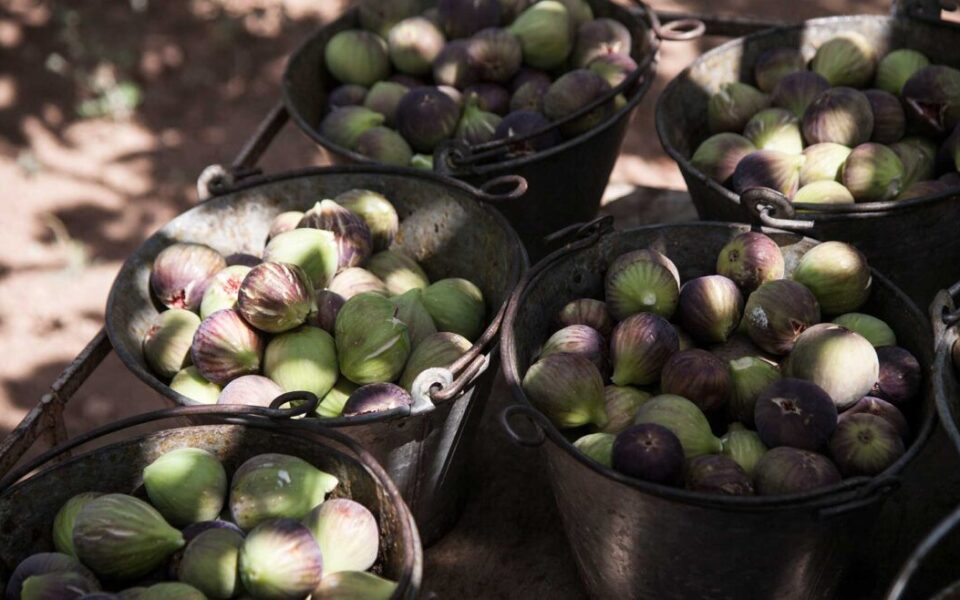Explainer: Everything you need to know about Greek figs


What are the main Greek varieties? Which ones can we find on the market? Is the fig really one of the least chemical-laden fruits? How was production this year?
In late August, fig trees produce fruit, though technically, a fig is an inverted flower that blooms internally. This is when fresh, sweet figs are ready to eat, but they spoil quickly unless preserved through traditional methods like making jams, chutneys or drying them. Fig spoon sweets are made from May’s male figs, which don’t develop into the familiar large fruit.
Figs thrive in the Mediterranean climate, with few commercial varieties. The trees can withstand temperatures as low as minus 5 degrees Celsius and require little spraying. This year’s fig season was early due to an extended heatwave. We learned more by talking to local farmers.


What fresh fig varieties are available at markets and stores?
In Greece, three main varieties of fresh figs are sold. Royal figs, especially from the Markopoulo-Vravrona region in East Attica, are a certified Protected Geographical Indication (PGI) product. They are large, with thin green skin that turns purple when ripe, and have rich, sweet flesh. Black figs from Markopoulo are smaller, with thicker skin, making them more durable for export. The Sultane de Marabout variety, known locally as Mission, has thin skin, is very sweet and is the only self-pollinating type.


Which varieties are used for drying?
The top varieties for drying are Kymi figs from Evia (Protected Designation of Origin [PDO] certified), Tsapeles from Kalamata in the Peloponnese, and the Smyrna variety Taxiarchis from northern Evia.
What do we know about the Smyrna variety Taxiarchis on Evia?
The Smyrna variety Taxiarchis figs were introduced to northern Evia by Asian Minor refugees who established villages and cultivated the land. These figs are renowned in their dried form, recognized as a PDO product known as “Dried Taxiarchis Figs PDO.” Currently, the cultivation covers 12 square kilometers (1,200 hectares) and produces over 8,000 tons annually.
“The unique aspect of these figs is their thin skin, which keeps them soft after drying, along with a high sugar content of about 65%,” says Nikos Koutsogiorgakis, director of the Taxiarchis Agricultural Cooperative. They are large enough that when packed together, they resemble the famous lamb offal dish “kokoretsi.” These figs are exported to France, Switzerland, the US and the United Arab Emirates in 5 and 10-kilogram packages.
Unknown fig varieties
The fig tree has hundreds of varieties, many of which are not suitable for commercial use due to their durability and appearance, but they still offer excellent flavor and sweetness. Notable lesser-known figs include white royal figs, white “apostoliatika,” traditional Chios figs called “abourkounes” and the “boukni” from Samos. The eggplant fig, commonly found on Evia, also grows in backyards and gardens.


How are figs pollinated, and what does that mean for their quality?
Figs are pollinated by fig wasps (Blastophaga psenes) that live in male fig trees, which produce flowers (which resemble fruit) but no actual fruit. The male fig appears in early April and falls off the tree in June. The wasps move from the male tree covered in pollen to female trees, pollinating them. Unpollinated figs wither and fall, while pollinated ones grow large and sweet, with the first fruit appearing in August. The Mission or Sultane de Marabout variety is self-pollinating and does not require the wasp.
Are figs less chemically treated than other fruits?
Yes. Fig trees have few pests and require minimal pesticide use, making them less chemically treated than fruit like pistachios, peaches and apricots.
How do we choose figs?
While figs usually don’t need pesticides, some growers may use chemical fertilizers or spray weeds around the trees. To avoid this, choose certified organic figs. Figs from unirrigated trees are often sweeter due to their concentrated flavor. Look for figs that are soft and appear ripe.


Are figs from May and June edible?
Yes, but these male figs and early-season figs are lower in quality and less sweet. They’re mostly used for making fig spoon sweets. The best figs ripen in August after pollination and are sweeter and of higher quality.
How was this year’s fig harvest?
This year’s fig harvest was early, with figs appearing about 10 days ahead of schedule, and it was one of the weakest in production. Growers faced three major challenges. First, a mild winter led to trees not bearing fruit. Second, prolonged heatwaves and drought caused the fig wasp to crack under the heat, resulting in poor pollination and lower-quality figs.
A third unexpected factor was the black fig fly, which thrived in ideal conditions, rapidly multiplied and attacked fig trees, destroying a significant portion of the male figs and further hindering pollination. This situation was compounded by ongoing issues with the Mediterranean fruit fly.
In contrast, the self-pollinating Mission variety fared much better this year. The ongoing climate crisis presents challenges for fig production that are likely to continue in the coming years, raising concerns for growers and prompting a shift toward self-pollinating varieties.


Source: ekathimerini.com




